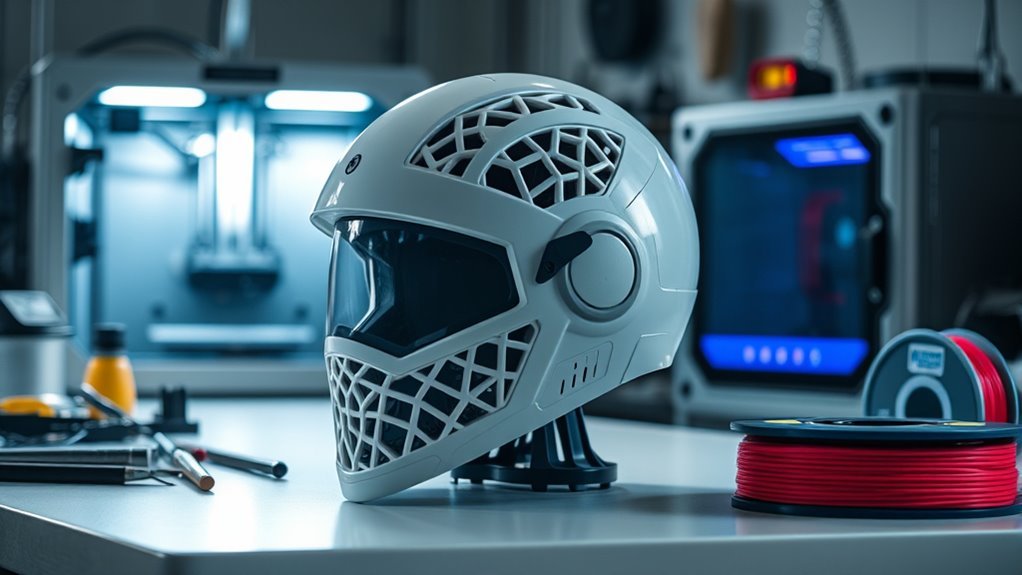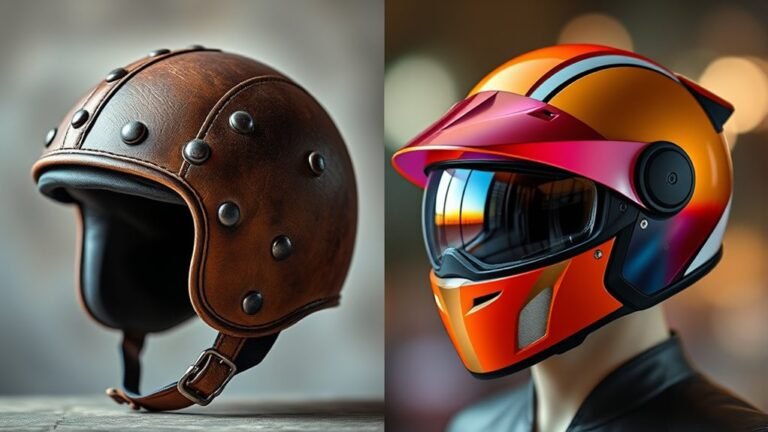How 3D Printing Is Changing Helmet Manufacturing
3D printing is revolutionizing helmet manufacturing by enabling rapid prototyping and customization to meet individual needs. This technology allows for tailored fit and enhanced safety through advanced materials that provide better impact absorption and reduce weight. Additionally, it minimizes material waste and production costs, making sustainable practices more feasible. As manufacturers adopt these innovative approaches, you’ll find that the future of helmet design is becoming increasingly focused on safety, comfort, and personal expression.
The Evolution of Helmet Design
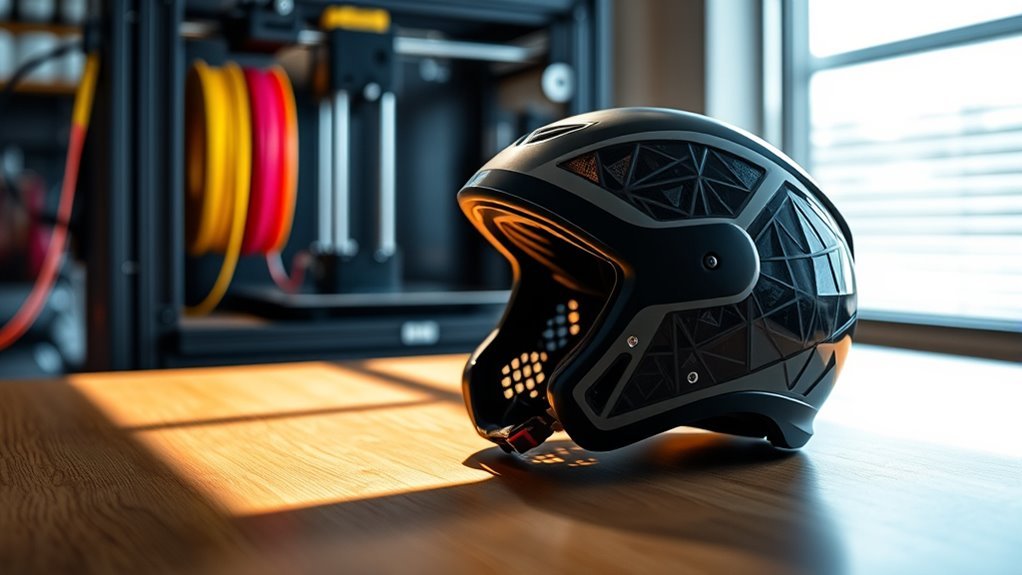
As helmet design has evolved over the years, it’s clear that advancements in technology and materials have considerably influenced safety and functionality. You’ll notice how historical influences shape current designs, with retro styles often re-emerging as a nod to the past. This blend of design aesthetics and modern engineering creates helmets that don’t just protect but also appeal visually. The use of lighter materials and improved impact absorption techniques reflects a commitment to user safety while maintaining comfort. Furthermore, the incorporation of ventilation systems showcases a shift towards practicality, allowing for extended wear without discomfort. Ultimately, this evolution emphasizes a balance between safety and personal expression, catering to your desire for freedom in both style and performance.
Customization for Individual Needs
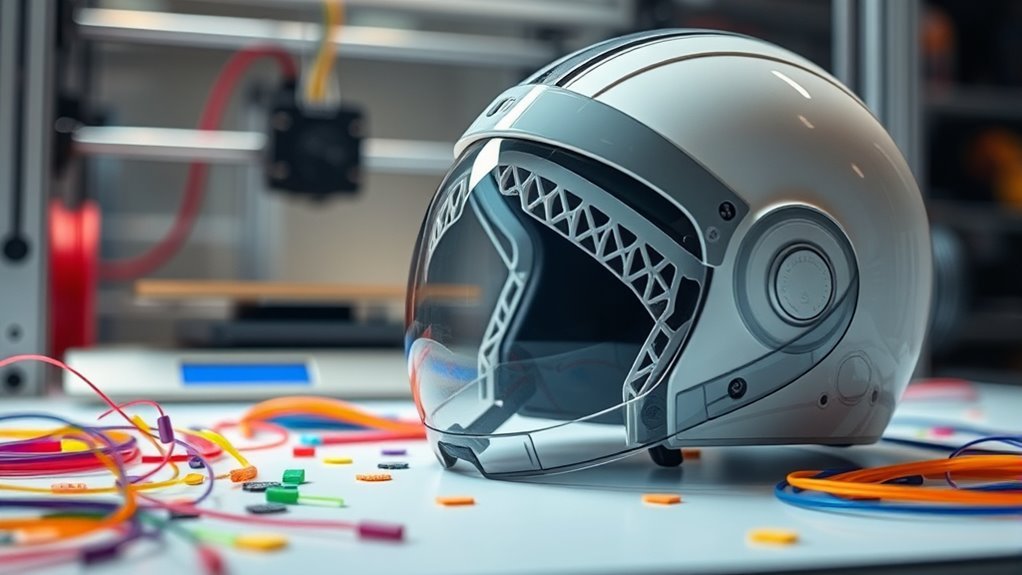
While traditional helmet designs often focus on a one-size-fits-all approach, the growing demand for customization reflects a deeper understanding of individual needs and preferences. With 3D printing technology, you can now enjoy personalized fittings that enhance comfort and performance. This innovation allows manufacturers to create helmets tailored specifically to your head shape, size, and even your aesthetic choices. By integrating user preferences into the design process, you can experience a level of personalization that wasn’t possible before. This shift not only improves the fit but also empowers you to express your individuality. As helmet manufacturing evolves, the ability to customize helmets will likely become a standard expectation, ensuring that you get exactly what you need for your riding experience.
Enhanced Safety Features
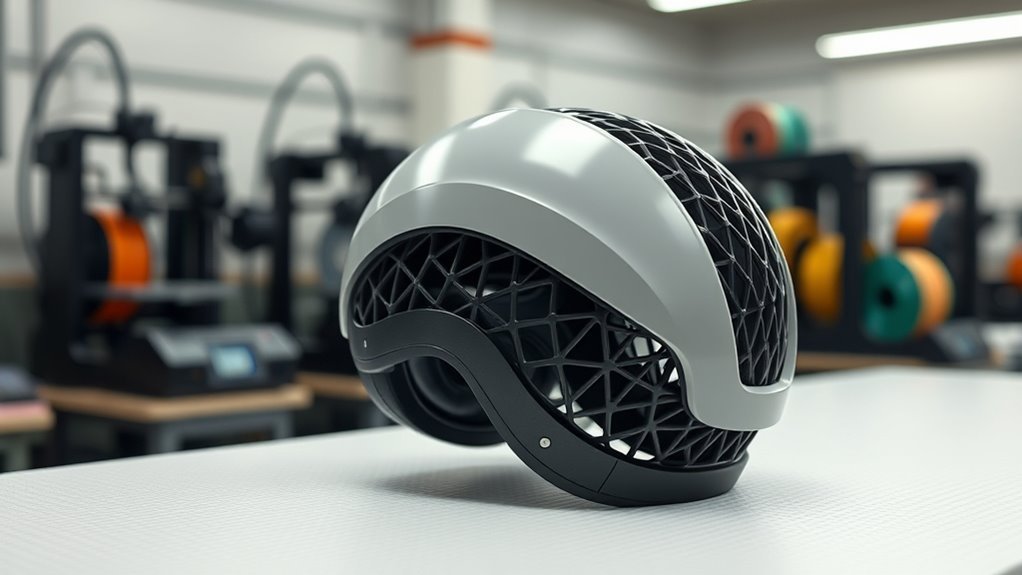
When considering helmet safety, custom fit design plays an essential role in ensuring maximum protection. Coupled with advanced impact absorption technologies and lightweight materials, these features not only enhance safety but also improve comfort and usability. Understanding how these elements work together can greatly influence your choice in helmet manufacturing.
Custom Fit Design
Custom fit design in helmet manufacturing represents a significant advancement in safety technology, as it allows for tailored protection that conforms to the unique shapes of individual users’ heads. This personalized comfort not only enhances user experience but also promotes better safety outcomes. By utilizing 3D printing, manufacturers can create helmets that feature ergonomic design, ensuring an ideal fit that reduces pressure points and enhances stability during use. This meticulous attention to detail means that helmets are less likely to shift or become dislodged in critical situations. As you embrace this innovation, you gain the freedom to choose a helmet that meets your specific needs, combining comfort and safety in a way that mass-produced options simply can’t achieve.
Impact Absorption Technologies
As advancements in helmet manufacturing continue to evolve, impact absorption technologies have emerged as essential enhancements that greatly improve safety features. These technologies focus on optimizing impact performance and energy dissipation, ensuring maximum protection during collisions. You’ll find several significant innovations that contribute to enhanced safety:
- Multi-layer foam systems that absorb and distribute energy more effectively
- Viscoelastic materials that adapt to varying impact forces for better shock absorption
- Smart materials that change properties upon impact, offering tailored protection
- 3D-printed lattice structures that provide strength while minimizing weight
Lightweight Materials Advantage
While the pursuit of safety in helmet manufacturing has traditionally prioritized impact absorption, the integration of lightweight materials has become vital in enhancing overall performance. Lightweight composites, like carbon fiber and advanced polymers, not only reduce the helmet’s weight but also improve comfort and maneuverability. This is essential for athletes and riders who require agility without sacrificing protection. Furthermore, these materials allow for more aerodynamic structures, which can minimize drag and enhance speed. By employing 3D printing techniques, manufacturers can create complex geometries that optimize both safety features and performance metrics. Ultimately, lightweight materials represent a significant advancement in helmet technology, ensuring you can enjoy your activities with greater freedom and peace of mind.
Rapid Prototyping and Testing
Given the rapid advancements in 3D printing technology, manufacturers can now create helmet prototypes more efficiently than ever before. This innovation allows for seamless rapid design iteration and thorough prototype testing, ultimately resulting in better products. Here are some key benefits:
- Speed: Prototypes can be produced in days, not weeks.
- Cost-effectiveness: Reduced material costs lead to budget-friendly testing.
- Customization: Tailor designs to meet specific user needs or preferences.
- Testing versatility: Quickly iterate designs based on real-world feedback.
This shift not only accelerates the development process but also enhances the overall quality of helmets, ensuring they meet safety standards while catering to individual preferences. Embracing these advancements can empower manufacturers to push the limits of helmet design.
Reducing Material Waste
In helmet manufacturing, you’re likely aware that reducing material waste is essential for both efficiency and sustainability. By leveraging 3D printing technology, you can optimize material usage and minimize excess, leading to more environmentally friendly production methods. This approach not only conserves resources but also enhances the overall cost-effectiveness of the manufacturing process.
Efficient Material Usage
As manufacturers increasingly adopt 3D printing technologies for helmet production, the potential for improving efficient material usage becomes evident. This innovative approach enhances material efficiency and promotes resource optimization, minimizing waste in the manufacturing process. Here are some key benefits:
- Precision Design: 3D printing allows for intricate designs that reduce excess material.
- Layer-by-Layer Production: This method builds helmets precisely, using only what’s necessary.
- Customization: Tailored helmets mean less material is wasted on ill-fitting products.
- Recyclable Materials: Many 3D printing materials can be recycled or reused, further enhancing efficiency.
Sustainable Production Methods
While many traditional manufacturing methods contribute markedly to material waste, sustainable production methods in helmet manufacturing aim to mitigate this issue through innovative practices. You’ll find that additive manufacturing, a key element of 3D printing, allows for precision in creating helmets, resulting in minimal waste. Unlike subtractive methods that cut away excess material, 3D printing builds your helmet layer by layer, using only what’s necessary. Additionally, the shift towards eco-friendly materials, such as biodegradable plastics and recycled composites, enhances sustainability by reducing the environmental impact. By embracing these practices, manufacturers can not only produce high-quality helmets but also align with a growing consumer demand for environmentally responsible products, fostering a future where freedom of choice includes sustainable options.
Cost-Effective Production
When considering the shift towards 3D printing in helmet manufacturing, one can’t overlook the significant cost savings it offers. This innovative technology enhances production efficiency and enables affordable manufacturing, making helmets more accessible. Here are a few ways 3D printing contributes to cost-effective production:
- Reduced material waste: 3D printing uses only the necessary amount of material, minimizing excess.
- Lower labor costs: Automation streamlines the production process, requiring fewer workers.
- Rapid prototyping: Designs can be created and tested quickly, reducing time-to-market.
- Customization: Tailoring helmets to specific needs becomes more feasible without incurring heavy costs.
Incorporating 3D printing can transform helmet manufacturing, allowing for more economical options for consumers while maintaining quality and safety.
The Role of Advanced Materials
Advanced materials play an essential role in revolutionizing helmet manufacturing through 3D printing, enhancing both safety and performance. By utilizing bio-based polymers, manufacturers can create lightweight yet strong helmets that reduce the environmental impact of production. These polymers offer flexibility and comfort, vital for users who prioritize freedom of movement. On the other hand, metal composites provide superior durability and impact resistance, ensuring that helmets can withstand the rigors of various activities. The integration of these advanced materials not only improves the structural integrity of helmets but also allows for innovative designs tailored to individual needs. As you explore helmet options, consider how these materials contribute to enhanced protection and performance, aligning with your desire for safety and freedom.
Challenges in Implementation
The integration of advanced materials in helmet manufacturing through 3D printing presents significant challenges that can hinder widespread adoption. You’ll encounter various obstacles that require careful navigation:
- Regulatory hurdles: Compliance with safety standards can complicate the design and production process.
- Technology limitations: Current 3D printing technologies may not consistently produce the required strength or durability.
- Material availability: Sourcing advanced materials that meet performance criteria can be difficult and costly.
- Cost considerations: Initial investment in 3D printing technologies can be prohibitive for smaller manufacturers.
These challenges necessitate a strategic approach, balancing innovation with practical considerations. As you explore this field, understanding and addressing these barriers is essential for successful implementation.
The Future of 3D Printed Helmets
As innovations in 3D printing technology continue to evolve, the future of 3D printed helmets looks promising yet complex. You’ll likely see future trends shaping the industry, such as customizable designs that cater to individual preferences and needs. Manufacturers are increasingly focusing on innovative designs that enhance safety while maintaining comfort and style. This personalization not only empowers consumers but also fosters a sense of ownership over their gear. Additionally, advancements in materials will lead to lighter, more durable helmets, potentially revolutionizing helmet safety standards. As these trends unfold, the helmet manufacturing landscape will shift, offering you options that align with your desire for freedom and self-expression while ensuring ideal protection. The future holds exciting possibilities for both designers and users alike.
Frequently Asked Questions
How Does 3D Printing Impact Traditional Helmet Manufacturing Jobs?
3D printing’s revolution in manufacturing could displace up to 20% of traditional helmet manufacturing jobs. As production shifts toward this innovative technology, workers must adapt their skills to remain relevant. This means embracing new techniques and understanding digital design processes. While job displacement is a concern, those who can pivot will find opportunities in advanced manufacturing roles. Adapting to these changes can empower you to thrive in a rapidly evolving industry landscape.
What Regulations Govern 3D Printed Helmets?
When it comes to regulations governing 3D printed helmets, you’ll find that helmet safety and manufacturing standards are essential. Organizations like the Consumer Product Safety Commission (CPSC) provide guidelines to guarantee helmets meet safety requirements. Additionally, manufacturers must adhere to standards set by ASTM International and the Snell Memorial Foundation. It’s vital that you stay informed about these regulations to make certain your helmet is compliant, offering the protection you need while enjoying your freedom.
Can 3D Printed Helmets Be Repaired After Damage?
Yes, 3D printed helmets can be repaired after damage, but it largely depends on the material durability and the extent of the damage. Repair techniques like adhesive bonding or replacing damaged components can be effective. However, if the structural integrity is compromised, it’s often safer to replace the helmet entirely. It’s crucial to assess the damage carefully to guarantee your safety and maintain the helmet’s protective capabilities.
How Long Does a 3D Printed Helmet Last?
A 3D printed helmet can last anywhere from a few months to several years, depending on durability factors like material choices and usage conditions. If you opt for high-quality materials such as nylon or reinforced polymers, you’re likely to get a longer lifespan. However, regular wear, exposure to harsh environments, and impacts can greatly affect its durability. It’s crucial to assess your specific needs and choose materials that balance performance and longevity.
Are 3D Printed Helmets Suitable for All Sports?
3D printed helmets can be suitable for various sports, but it’s essential to guarantee they meet safety standards specific to each activity. The material options available can influence their performance and protection level. For example, some materials may provide better shock absorption than others. Always check that the helmet adheres to the necessary regulations for your sport, and consider the intensity and risks involved to secure your safety while enjoying your freedom.
